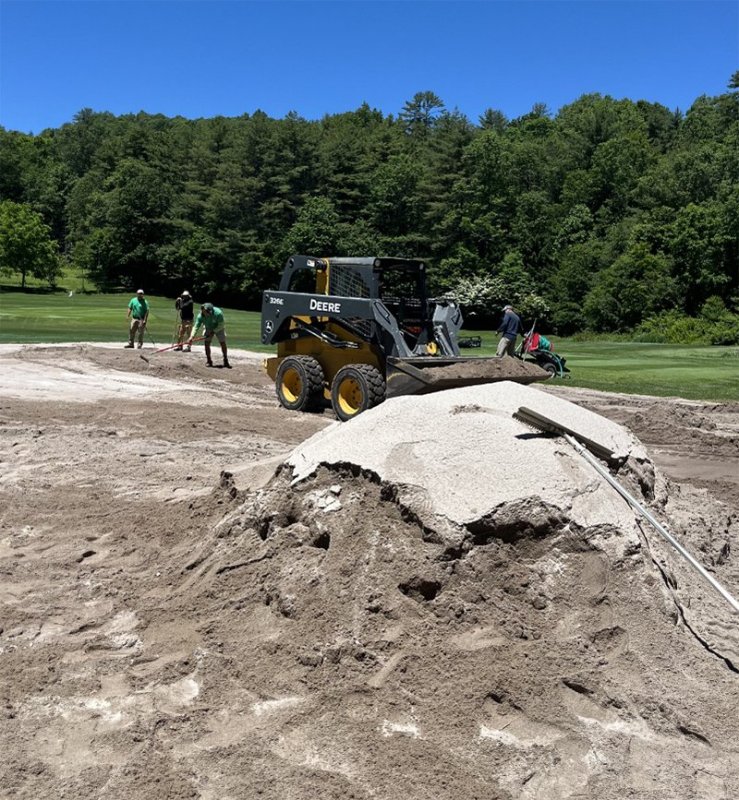As a self-described lifelong learner and an impassioned and creative thinker, Brian Stiehler, like so many of his colleagues, fits the mold of being a research scientist as well as a golf course superintendent.
 The head greenkeeper of Highlands Country Club for the past 23 years, Stiehler (right) has regularly maintained a nursery on the property in Highlands, North Carolina.
The head greenkeeper of Highlands Country Club for the past 23 years, Stiehler (right) has regularly maintained a nursery on the property in Highlands, North Carolina.
The putting surfaces at Highlands, a 1928 Donald Ross design, were seeded with Penn A4 creeping bentgrass in 1998, three years before Stiehler's arrival. Thanks to tree and shade issues, the amount of Poa annua on the greens ranges from 10 percent to 90 percent, according to Stiehler.
To that end, the 5,000-square-foot nursery routinely included some amount of Penn A4 creeping bentgrass. But there was always more to that nursery, at least in the past decade, than growing turf for repairs and regrassing projects. And years of monitoring those various turf varieties has yielded the best choice for Highlands' greens. It is a simple template that can easily be replicated anywhere.
"My nursery has always been an experimentation place," Stiehler said. "There has always been some Penn A4 on it. But seven or eight years ago, I gridded out the nursery with the most popular bentgrasses. It was like my own NTEP trial. I wanted to see what was the best bentgrass in case we ever redid our greens."
Part of that test nursery was the a seeded Poa annua developed by Penn State plant breeder David Huff, Ph.D.
"He developed the first harvested Poa seed, and asked if I would do a plot at Highlands. It did really well."
After years of analysis, Stiehler has settled on what he believes is the best turf option for Highlands, and is converting the nursery from its former use as a research plot to one for harvesting purposes.
Although a few varieties fared well, including Huff's seeded Poa and Pure Distinction creeping bentgrass, Penn A4 stood out from the crowd at Highlands, which has an elevation of nearly 4,000 feet and receives an average of 80 to 100 inches of precipitation annually.
"This is a very unique climate. It's ideal for growing cool-season grass," he said. "You'd think any grass would do well, but some didn't. I'm not sure why, but I think rainfall has something to do with it. You can't control (rain) water. We spend more time trying to get rid of water.
My nursery has always been an experimentation place. There has always been some Penn A4 on it. But seven or eight years ago, I gridded out the nursery with the most popular bentgrasses. It was like my own NTEP trial. I wanted to see what was the best bentgrass in case we ever redid our greens.
"We were testing eight different types. I was always partial to Tee 2 Green (varieties) because I went to Penn State. Some of the others just didn't do well."
The new nursery will yield benefits almost immediately during a renovation of the Nos. 12 and 14 greens later this year. That project will involve enlarging the putting surfaces to increase the number of pinnable options on both greens."
Despite the age of the greens at Highlands, turf quality precludes any further work on the putting surfaces other than the enlargement project on 12 and 14.
"At some point we probably will, but the greens are so good there's no reason to," Stiehler said. "The Poa sticks out in the spring, but by late May, it's a pretty homogenous mix. And we have zero thatch. I'm proud of how we managed that. The USGA says the life of a green is 20 to 25 years. I understand what they're saying, but if you have a supportive membership, there's no reason they can't last 35 to 40 years or longer. Besides, when you seed greens to bentgrass, your membership wants to keep the bentgrass as long as you possibly can.
The only reason to rebuild is if you want to regrass them. Otherwise, there is no reason to blow them up."


